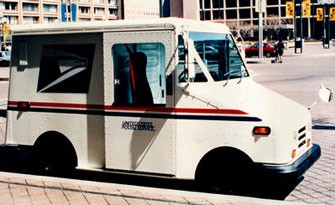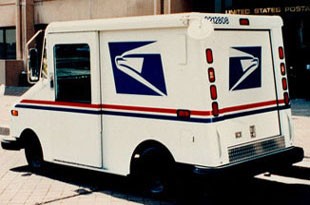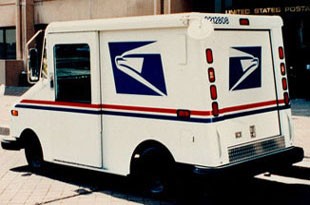Post Office Study: EV Economics Depend on Smart-Grid Revenue 7 comments
On August 28th, the Office of the Inspector General of the U.S. Postal Service published the results of a feasibility study titled, "Electrification of Delivery Vehicles." While the feasibility study reaches a foregone conclusion and recommends the purchase of a 3,000 unit demonstration fleet, I was surprised by the high level of Federal subsidies the Inspector General thought necessary to bring EVs within Postal Service capital investment policies. I was even more surprised by the conclusion that the tipping point in the economic analysis was revenue from ancillary vehicle to grid, or V2G, services.
The Postal Service operates a fleet of 219,000 vehicles, including 146,000 delivery vehicles. The feasibility study focused on the long-life vehicles, or LLVs, that have been a part of the American landscape since the late 80's.


The current version of the LLV is built on a GM truck chassis, costs the Postal Service about $19,000 and gets about 10 miles per gallon; which isn't bad for the kind of low-speed stop-start driving on a typical mail route. The average LLV is driven about 18 miles a day and roughly 96% of the LLV fleet drives less than 40 miles a day. The vast majority of LLVs are parked at Postal Service facilities from 5 p.m. till 8 a.m.
The proposal evaluated in the Postal Service feasibility study would replace the internal combustion engine and drive train with an electric drive and 20 kWh of lithium-ion batteries of unspecified chemistry. The projected cost of a 3,000-unit fleet of electric LLVs, or E-LLVs, is $120 million, or $40,000 per unit. The projected cost of associated charging station infrastructure and training is $16.75 million.
The most striking aspect of the Inspector General's report is the fact that it was written from the perspective of an EV buyer, rather than an EV seller. After years of reading up-beat promotional materials that talk about ten-year battery lives and seven- to ten-year payback periods, it was refreshing to see a more skeptical buyer's analysis that:
- Assumed the battery pack would have to be replaced after five years;
- Assumed a fifty percent reduction in repair and maintenance costs;
- Assumed a stable correlation between gasoline and electricity prices;
- Required internal returns of thirty percent per year like you see in most businesses;
- Required payback periods of less than three years like you see in most businesses;
- Concluded that substantial Federal subsidies were essential; and
- Concluded that ancillary revenues from V2G services were essential.
The Inspector General's report was not overly kind to E-LLVs, but then I've never expected undue kindness from fleet buyers who are invariably constrained by capital spending policies that require a return on investment, as opposed to a return of investment. The good news for EV developers is that the Inspector General was able to put together a plan that worked for the Postal Service. The bad news is the plan will be difficult for other fleet users to duplicate because the feasibility study assumes that:
- The Postal Service will get grants for 74% of the cost difference between a standard LLV and an E-LLV;
- The Postal Service will save roughly $1,300 per vehicle year from reduced fueling costs;
- The Postal Service will save roughly $1,500 per vehicle year from reduced maintenance; and
- The Postal Service will earn roughly $2,300 per vehicle year from V2G services.
The Inspector General's report analyzed four possible scenarios. In the basic scenario of no grants and no V2G revenue, the E-LLVs were a poor investment that had a negative return over ten years. In two middle of the road scenarios that included (a) grants without V2G revenues and (b) V2G revenues without grants, the payback periods were in the five-year range and internal rates of return were 15% to 20%. In a best-case scenario that included both grants and V2G revenue, the payback period was under two years and the internal rate of return was over 60%. Since the Postal Services has influential friends in high places, I think it's a safe bet that they'll be able to negotiate the details of a best case project.
The only thing that concerns me about the strategy the Postal Service has adopted for its E-LLV demonstration fleet is the long-term stability of V2G revenue. The E-LLV fleet will be on the road every day from 8 a.m. to 5 p.m., the precise period when demands on the power grid are greatest. So while the proposed fleet of 3,000 E-LLVs will have the theoretical ability to provide 45 MW of frequency regulation services, it will only be able to provide frequency regulation services when demand for those services is relatively low. While I've not been able to find any detailed estimates of the national demand for frequency regulation services during off-peak hours, I have to assume that the aggregate demand for frequency regulation is smaller than demand for other grid-based storage systems. I also have to assume that V2G services will compete directly with alternatives like the flywheel systems that Beacon Power (BCON) is developing which will be available 24/7.
Overall, I believe the Postal Service proposal to deploy a fleet of 3,000 E-LLVs presents an unparalleled opportunity to provide a reliable real-world testing laboratory for ideas that have not yet been reduced to practice. The Postal Service has long promised "neither snow, nor rain, nor heat, nor gloom of night, nor the winds of change, nor a nation challenged, will stay us from the swift completion of our appointed rounds." Since one of the biggest challenges facing America is the efficient use of energy and the prevention of waste, I can't imagine a better organization to lead the way.
In a perfect world, the Postal Service would break its planned E-LLV fleet into as many as a half-dozen subgroups that would each use a different battery chemistry from a different vendor. The willing industry participants I can identify off the top of my head include Altair Nanotechnologies (ALTI), Ener1 (HEV), Johnson Controls (JCI), Valence Technologies (VLNC), and A123 Systems (IPO pending). With proper monitoring, the amount and relative uniformity of the data generated in the first few years of testing for both EV and V2G applications could be priceless.
As a side note, I'm pleased to announce that I've accepted an invitation to appear as a luncheon speaker at the Electrical Energy Storage Applications and Technologies conference in Seattle on October 4th through 7th. While bloggers like me frequently get invited to speak at investment conferences, EESAT is in an entirely different animal. It's a biennial international technical conference co-sponsored by the DOE, Sandia National Laboratories and the Electricity Storage Association. The agenda currently includes technical presentations from the U.S. and eleven foreign countries. EESAT is not appropriate for investors, but it's a must for companies that are active in the energy storage sector and for institutional investors who need to better understand why storage is important and where the growth opportunities lie.
Postal Service Set to Lead the Way in Deploying Electric Fleet 18 comments
On August 28th, the Office of the Inspector General of the U.S. Postal Service published the results of a feasibility study titled, "Electrification of Delivery Vehicles." While the feasibility study reaches a foregone conclusion and recommends the purchase of a 3,000 unit demonstration fleet, I was surprised by the high level of Federal subsidies the Inspector General thought necessary to bring EVs within Postal Service capital investment policies. I was even more surprised by the conclusion that the tipping point in the economic analysis was revenue from ancillary vehicle to grid, or V2G, services.
The Postal Service operates a fleet of 219,000 vehicles, including 146,000 delivery vehicles. The feasibility study focused on the long-life vehicles, or LLVs, that have been a part of the American landscape since the late 80's.

The current version of the LLV is built on a GM truck chassis, costs the Postal Service about $19,000 and gets about 10 miles per gallon; which isn't bad for the kind of low-speed stop-start driving on a typical mail route. The average LLV is driven about 18 miles a day and roughly 96% of the LLV fleet drives less than 40 miles a day. The vast majority of LLVs are parked at Postal Service facilities from 5 p.m. till 8 a.m.
The proposal evaluated in the Postal Service feasibility study would replace the internal combustion engine and drive train with an electric drive and 20 kWh of lithium-ion batteries of unspecified chemistry. The projected cost of a 3,000-unit fleet of electric LLVs, or E-LLVs, is $120 million, or $40,000 per unit. The projected cost of associated charging station infrastructure and training is $16.75 million.
The most striking aspect of the Inspector General's report is the fact that it was written from the perspective of an EV buyer, rather than an EV seller. After years of reading up-beat promotional materials that talk about ten-year battery lives and seven- to ten-year payback periods, it was refreshing to see a more skeptical buyer's analysis that:
- Assumed the battery pack would have to be replaced after five years;
- Assumed a fifty percent reduction in repair and maintenance costs;
- Assumed a stable correlation between gasoline and electricity prices;
- Required internal returns of thirty percent per year like you see in most businesses;
- Required payback periods of less than three years like you see in most businesses;
- Concluded that substantial Federal subsidies were essential; and
- Concluded that ancillary revenues from V2G services were essential.
The Inspector General's report was not overly kind to E-LLVs, but then I've never expected undue kindness from fleet buyers who are invariably constrained by capital spending policies that require a return on investment, as opposed to a return of investment. The good news for EV developers is that the Inspector General was able to put together a plan that worked for the Postal Service. The bad news is the plan will be difficult for other fleet users to duplicate because the feasibility study assumes that:
- The Postal Service will get grants for 74% of the cost difference between a standard LLV and an E-LLV;
- The Postal Service will save roughly $1,300 per vehicle year from reduced fueling costs;
- The Postal Service will save roughly $1,500 per vehicle year from reduced maintenance; and
- The Postal Service will earn roughly $2,300 per vehicle year from V2G services.
The Inspector General's report analyzed four possible scenarios. In the basic scenario of no grants and no V2G revenue, the E-LLVs were a poor investment that had a negative return over ten years. In two middle of the road scenarios that included (a) grants without V2G revenues and (b) V2G revenues without grants, the payback periods were in the five-year range and internal rates of return were 15% to 20%. In a best-case scenario that included both grants and V2G revenue, the payback period was under two years and the internal rate of return was over 60%. Since the Postal Services has influential friends in high places, I think it's a safe bet that they'll be able to negotiate the details of a best case project.
The only thing that concerns me about the strategy the Postal Service has adopted for its E-LLV demonstration fleet is the long-term stability of V2G revenue. The E-LLV fleet will be on the road every day from 8 a.m. to 5 p.m., the precise period when demands on the power grid are greatest. So while the proposed fleet of 3,000 E-LLVs will have the theoretical ability to provide 45 MW of frequency regulation services, it will only be able to provide frequency regulation services when demand for those services is relatively low. While I've not been able to find any detailed estimates of the national demand for frequency regulation services during off-peak hours, I have to assume that the aggregate demand for frequency regulation is smaller than demand for other grid-based storage systems. I also have to assume that V2G services will compete directly with alternatives like the flywheel systems that Beacon Power (BCON) is developing which will be available 24/7.
Overall, I believe the Postal Service proposal to deploy a fleet of 3,000 E-LLVs presents an unparalleled opportunity to provide a reliable real-world testing laboratory for ideas that have not yet been reduced to practice. The Postal Service has long promised "neither snow, nor rain, nor heat, nor gloom of night, nor the winds of change, nor a nation challenged, will stay us from the swift completion of our appointed rounds." Since one of the biggest challenges facing America is the efficient use of energy and the prevention of waste, I can't imagine a better organization to lead the way.
In a perfect world, the Postal Service would break its planned E-LLV fleet into as many as a half-dozen subgroups that would each use a different battery chemistry from a different vendor. The willing industry participants I can identify off the top of my head include Altair Nanotechnologies (ALTI), Ener1 (HEV), Johnson Controls (JCI), Valence Technologies (VLNC), and A123 Systems (IPO pending). With proper monitoring, the amount and relative uniformity of the data generated in the first few years of testing for both EV and V2G applications could be priceless.




